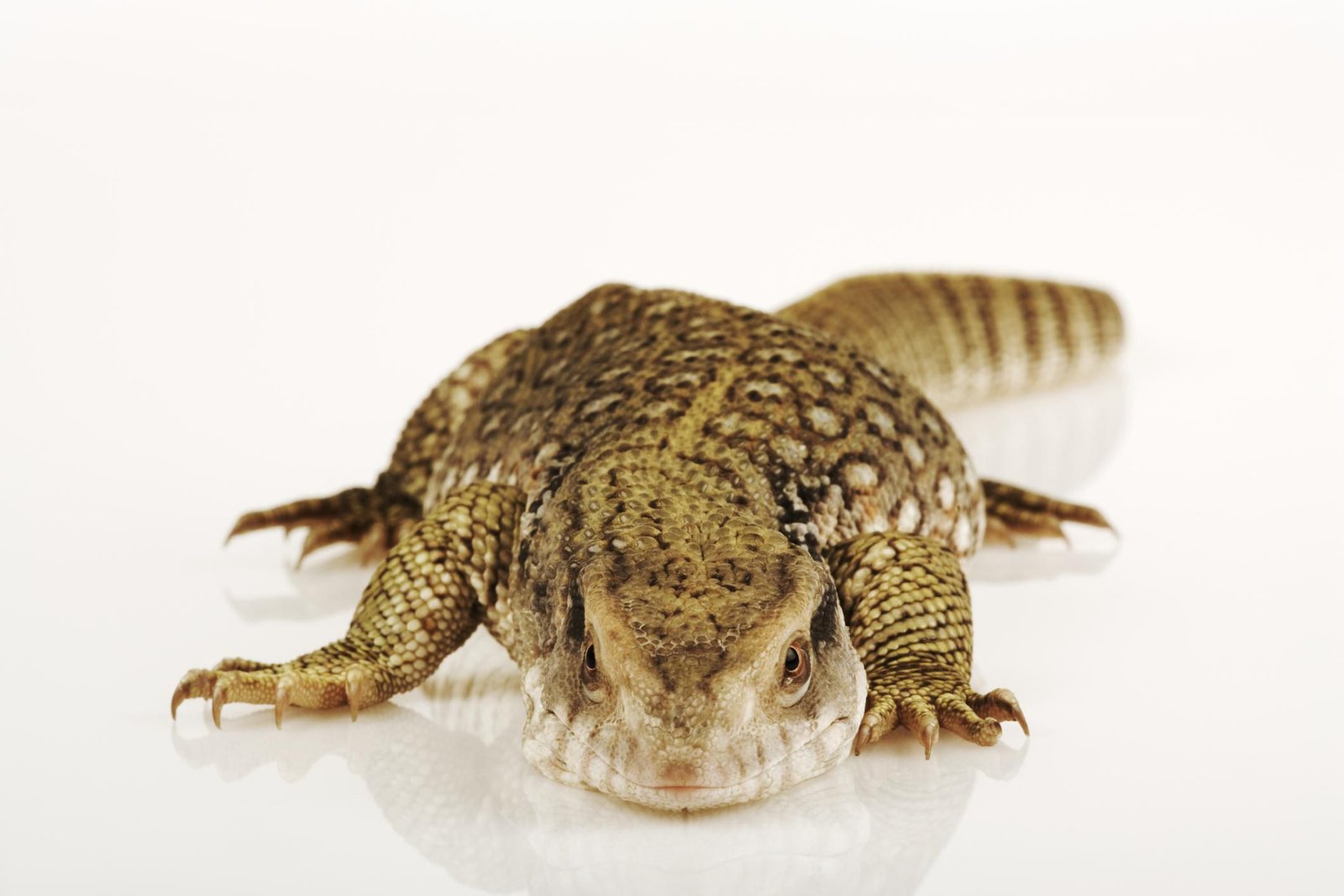The Savannah Monitor is a large, robust lizard with powerful limbs and jaws, known for its docile temperament. They have a dark grey coloration with lighter tan or yellow patterns, and are commonly found in the savannahs of eastern and southern Africa.
This species is one of the more popular pet lizards due to its manageable size and ease of handling. They are well-adapted for digging and have blunt, peglike teeth. If you’re considering getting a pet lizard, the Savannah Monitor is a great choice.

Credit: www.thesprucepets.com
Characteristics And Behavior
The Savannah Monitor, also known as Varanus exanthematicus, is a fascinating reptile with unique characteristics and behavior. In this section, we will explore the physical characteristics and behavior of the Savannah Monitor, shedding light on what makes them stand out as captivating pets.
Physical Characteristics
The Savannah Monitor possesses a stout build, characterized by relatively short limbs and toes. These features enable them to adapt to their environment and effectively hunt for food. With a robust skull and dentition, they are equipped to consume hard-shelled prey.
The skin coloration patterns of Savannah Monitors vary depending on their native habitat substrate. Typically, they sport a dark grey hue, adorned with lighter tan or yellowish patterns. This coloration not only helps them blend into their surroundings but also adds to their visual appeal as pets.
Behavior And Temperament
When it comes to behavior, Savannah Monitors exhibit fascinating traits that make them a popular choice among reptile enthusiasts. Despite their large size, they are considered one of the more docile species in the monitor group.
Savannah Monitors are known for their relatively low activity levels, often preferring a more leisurely lifestyle. This makes them a great choice for individuals looking for a pet lizard that doesn’t demand constant stimulation or attention.
In addition to their calm temperament, Savannah Monitors are known to tolerate handling relatively well. While it is important to establish trust and handle them properly, they usually respond positively to gentle interaction with their owners. This characteristic makes them an appealing choice for reptile enthusiasts who enjoy the companionship of their pets.

Credit: www.reddit.com
Care And Husbandry
The Savannah Monitor is a popular choice among reptile enthusiasts due to its docile nature and manageable size. However, just like any other pet, they require specific care and husbandry to ensure their well-being and longevity. In this section, we will discuss the essential aspects of caring for a Savannah Monitor, including housing and enclosure, temperature and lighting, diet and feeding, water requirements, and handling and interaction.
Housing And Enclosure
Proper housing and enclosure are crucial for the health and happiness of your Savannah Monitor. As an adult, they require a spacious enclosure that can accommodate their size and activity level. A glass terrarium or a wooden enclosure with secure locks is recommended to prevent escape.
When it comes to the size of the enclosure, a general rule of thumb is to provide a space that is at least four times the length of the monitor and twice the width. A minimum enclosure size for an adult Savannah Monitor would be 8 feet long, 4 feet wide, and 6 feet tall. Providing ample floor space allows them to roam, climb, and burrow, mimicking their natural habitat.
The enclosure should be furnished with a variety of hiding spots, branches, rocks, and substrate for burrowing. Keep in mind that Savannah Monitors are excellent diggers, so providing deep substrate like sand or topsoil is recommended.
Temperature And Lighting
Creating the right temperature gradient in the enclosure is essential for the health of your Savannah Monitor. They require a basking spot with a temperature ranging from 100°F to 115°F (37°C to 46°C). This can be achieved by using a basking lamp or ceramic heat emitter.
The ambient temperature in the enclosure should range between 80°F to 90°F (27°C to 32°C) during the day and drop to 75°F to 80°F (24°C to 27°C) at night. Using a thermostat or temperature gradient is highly recommended to ensure accurate temperature regulation.
In addition to temperature, proper lighting is crucial for your Savannah Monitor’s overall health. They require UVB lighting to aid in calcium absorption and prevent metabolic bone disease. It is essential to provide a full spectrum UVB bulb and provide a 12-hour light and dark cycle to mimic their natural environment.
Diet And Feeding
The Savannah Monitor is an omnivorous reptile with a diverse diet. They primarily feed on insects, such as crickets, mealworms, and roaches. Additionally, a significant portion of their diet should consist of a variety of fruits and vegetables to ensure proper nutritional balance.
It is important to provide a varied diet to prevent nutritional deficiencies. Dusting the insects with calcium and multivitamin supplements is also recommended to meet their dietary needs. Feeding should be done in moderation and adjusted based on the monitor’s age and size.
Water Requirements
Like all living creatures, the Savannah Monitor requires access to fresh and clean water at all times. Use a sturdy water dish that is large enough for them to soak in, as they often enjoy spending time in the water. Ensure that the water dish is easily accessible but secured to prevent tipping.
Regularly check the water dish to ensure it is clean and free of debris. It is important to remember that humidity is also crucial for their health, so maintaining a humidity level of 40% to 60% is recommended. This can be achieved by misting the enclosure or using a reptile humidifier.
Handling And Interaction
Savannah Monitors are generally tolerant of handling but may become stressed or aggressive if mishandled or mishandled frequently. When interacting with your monitor, it is important to approach them calmly and with gentle movements. Avoid sudden, loud noises or abrupt movements that may startle them.
Always support their body properly and avoid gripping them too tightly. Remember that each monitor has its own personality and tolerance levels, so it is important to respect their boundaries. Regular handling and interaction will help build trust and strengthen your bond with your Savannah Monitor.

Credit: www.shutterstock.com
Frequently Asked Questions Of Savannah Monitor: Species Profile
What Are The Characteristics Of A Savannah Monitor?
Savannah monitors have powerful limbs for digging, strong jaws, and blunt teeth. Their skin color varies but is usually dark grey with lighter tan or yellow patterns. They are docile and tolerate handling well.
What Size Tank Does A Savannah Monitor Need?
A Savannah monitor needs a tank that is appropriate for its size, preferably a large enclosure that is at least 6 feet long.
What Is The Sub Species Of The Savannah Monitor?
The sub-species of the savannah monitor is Varanus exanthematicus.
Do Savannah Monitors Like To Be Held?
Savannah monitors are large pet lizards that are one of the more docile species of the monitor group. They usually tolerate handling.
Conclusion
The Savannah Monitor is a fascinating species of pet lizard that is known for its robust nature and docile temperament. With its powerful limbs, jaws, and unique skin coloration, it is an intriguing addition to any reptile enthusiast’s collection. They are relatively easy to care for and are not overly active creatures, making them suitable for handling.
If you’re looking for a unique and captivating pet, the Savannah Monitor is definitely worth considering.

